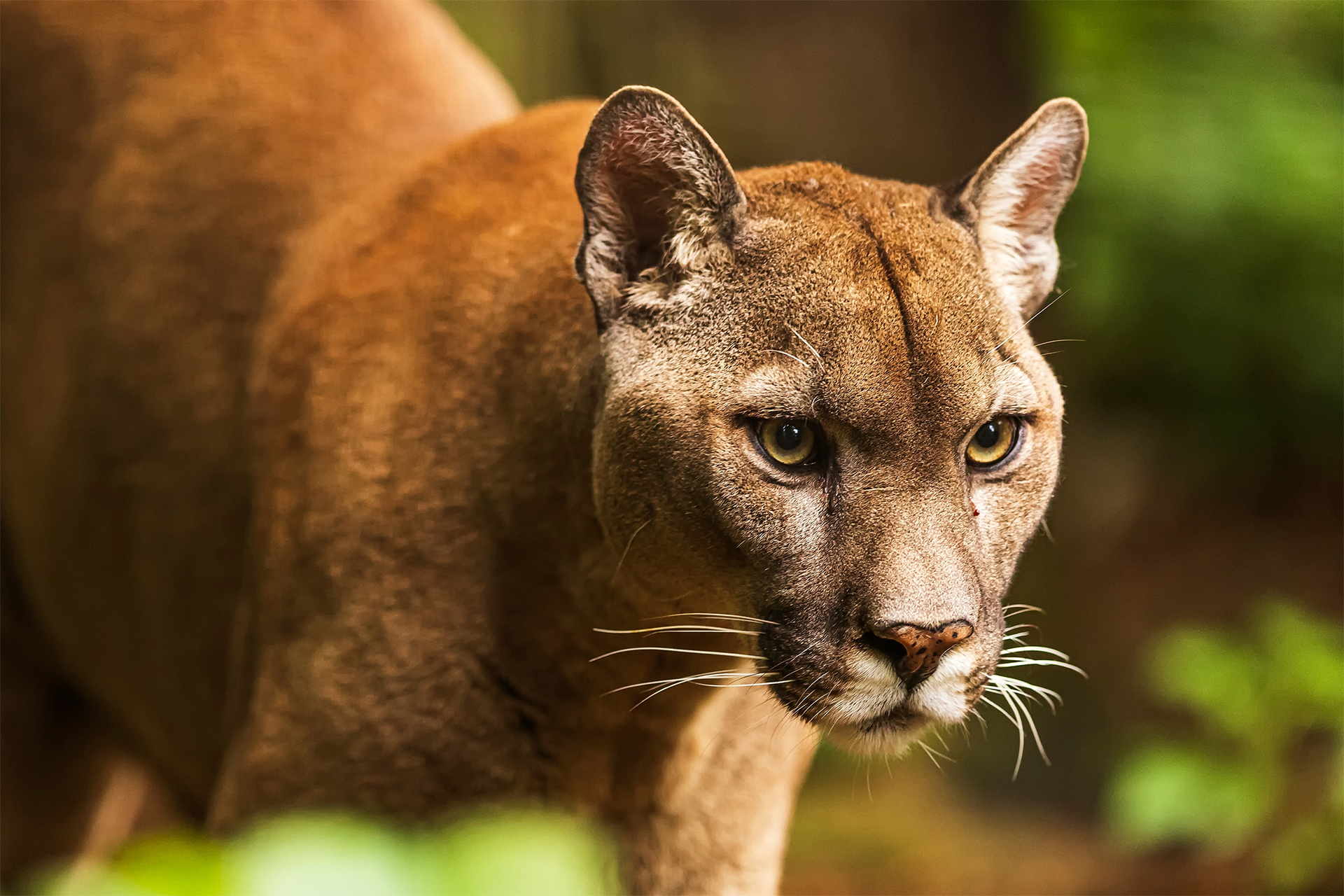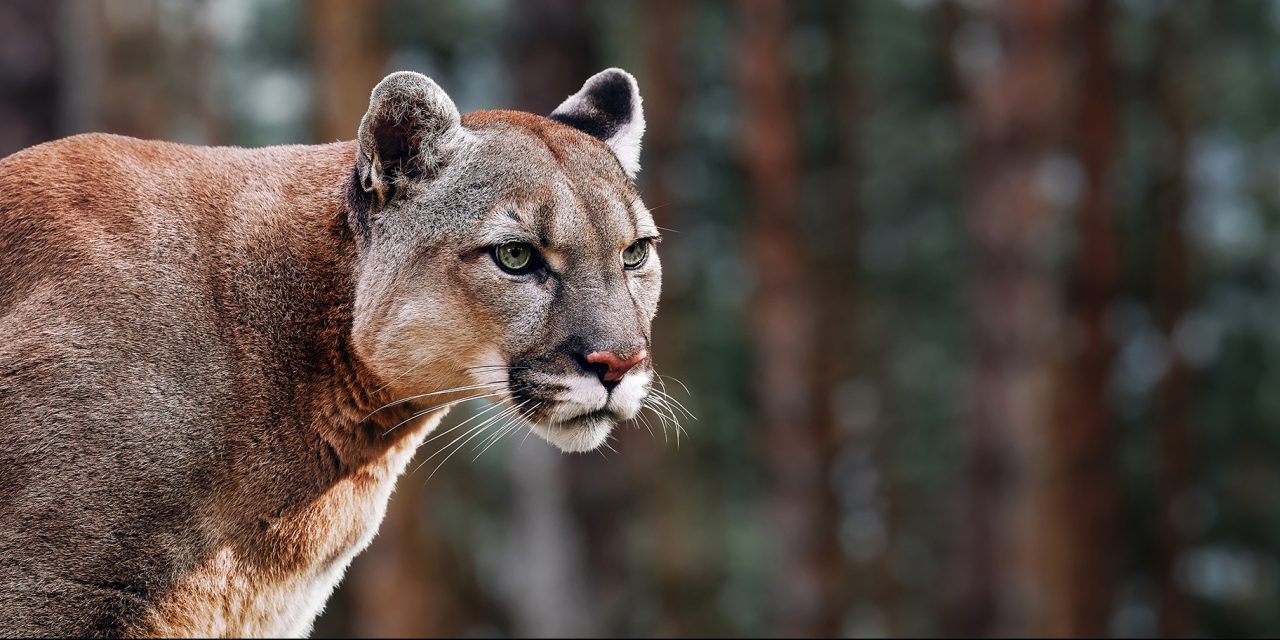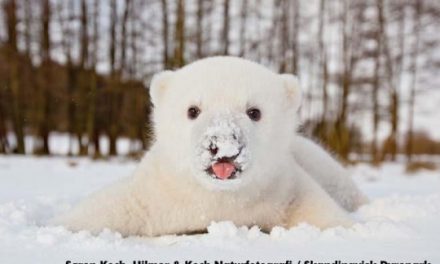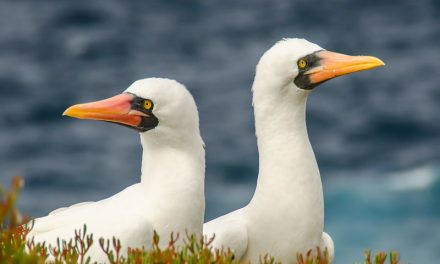Did you know that mountain lions have the largest geographic range of any non-human land mammal in the Western Hemisphere? It’s no surprise this magnificent animal, native to the Americas, is called many things: puma, catamount, cougar, painter and panther. The reason is that people from various countries, from Chile to Canada, have different names for it. The animal also has a multitude of nicknames, such as the ghost of the Rockies, red tiger and mountain screamer, among others.
Meet Puma Concolor
No matter what you call it, it’s still the same wild cat, scientifically known as Puma concolor, which means a large feline resembling a lion with one solid color. However, these beauties come in a range of shades, from rust and grayish to a tawny tan, and their babies are spotted. Dark-colored markings are found on the ears, around the snout and on the tip of the tail.
These predators sport a powerful body with short legs, upright ears, large paws, sharp claws, striking steely eyes and a long tail. Their hind legs are larger and more muscular than their front, giving them great jumping power.
A fun fact about these large cats is that they cannot roar like lions. Instead, they hiss, purr or growl, like domestic cats!

Although the mountain lion is the only large cat species with an increasing population, its current numbers still don’t rival those of its past. It continues to face threats due to prey depletion, human-wildlife conflict and habitat loss from agricultural and urban development.
Keep reading to learn more about these fascinating mammals, how to help ensure their survival, and where to see them.
Wild Cats: What’s in a Name?
Because the mountain lion has such a wide range, spanning 28 countries and 16 states in the U.S., it goes by many names. In fact, it has so many names in English alone (around 40) that it holds the Guinness Book of World Records distinction.
In North America, the feline is often referred to as mountain lion, cougar and panther, the last mainly in Florida. Spanish explorers in North and South America referred to it as gato monte (cat of the mountain) and leon (lion), which morphed to mountain lion over the years.
The term cougar may have come from an old word that the Portuguese picked up in Brazil: çuçuarana. More common references are the Colorado cougar and Yuma (Arizona) cougar. East of Mississippi, the animal is also called catamount, deer tiger and painter.

A panther walks through the tall grasses of Florida’s diverse terrain. You may be able to spot one on a Florida Nature Safari!
The word panther encompasses all cats featuring a solid-colored coat, and it is applied to big cats, such as mountain lions, as well as jaguars and leopards that are black in color. The Florida panther, the state’s official animal, is a subspecies of the mountain lion. While not black in color, it features tawny-beige fur and a curved tail. It is one of the most endangered mammals in the world.
The Incas of South America called the animal puma in their language, and it has a symbolic significance representing strength, wisdom and intelligence. It is still referred to as such in the countries that it calls home.
Range and Where to See Them
The mountain lion is an adaptable big cat that can live, as its name suggests, in the mountains. But it also thrives in deserts, forests, prairies and wetlands and is even seen in the fringes of cities.

Chasing after prey in Florida’s forests.
Mountain lions are found in 14 western states. The Florida panther only calls the Everglades National Park and Big Cypress National Preserve home. There was a time when these predators were found across the South, from Louisiana to South Florida. Their numbers dwindled to as few as 25 to 30 by the early 1990s.
Today, there are about 200 cats left in Florida’s swamplands. Lucky travelers may spot the endangered animal on Nat Hab’s Florida Nature Safari in the Corkscrew Swamp Sanctuary, situated in the Western Everglades.

Living life on the edge in South America’s high-altitude environment.
Puma sightings are also possible in Brazil, Chile, Peru and Colombia, among others. Guests on Nat Hab’s Brazil adventure can look for them in the Pantanal tropical wetland. In Patagonia, the puma is the largest predator, and its range spans from Arica to Magallanes at the tip of Chile. On Nat Hab’s Patagonia Wilderness & Wildlife Explorer journey, these animals can be spotted in Torres del Paine National Park.

A denning site in Torres del Paine National Park.
It seems that geographic location determines the size and color of the animal. They are smaller near the equator and larger around the poles. Males weigh anywhere from 115 to 220 pounds and females between 64 to 141 pounds. Mountain lions in colder climates tend to have longer and thicker hair in a silver-gray color, while those in warmer and humid regions are reddish brown.
Survival
These robust felines are ambush predators who stalk their prey around dawn and dusk before pouncing and killing it with their strong jaws. Similar to the cheetah, the mountain lion has a flexible spine that helps it move around obstacles and quickly change direction when needed.
Cougars are carnivores and consume small mammals, such as deer and guanaco (a camelid native to South America). They also hunt sheep, feral pigs, raccoons, armadillos, squirrels, hares and even porcupines. Stronger ones will even go after elk and moose. The animal is known to bury its food to come back and feast on later.

Mountain lions are elusive and don’t like confrontation with humans. Encountering one on a hike or in your neighborhood is unlikely. Avoid going out in mountain lion areas at dawn and dusk (when they hunt) to prevent any encounters. When camping, never leave food out.
Conservation
Mountain lions are listed as of least concern on the IUCN Red List; however, their population is on the decline. In the U.S., the Florida panther is protected under the Endangered Species Act. Sadly, the Eastern cougar was declared extinct in 2018, with the last confirmed sighting in 1938.
Until the arrival of European settlers in the late 1800s, these felines roamed wild spaces from Canada’s Yukon to the tip of South America, from the Atlantic to the Pacific. Soon after, mountain lion habitat began to disappear, along with their prey. These beautiful animals were killed for their fur and to protect livestock. They were considered vermin, and bounty programs were introduced to control their numbers in the West in the 1940s. This caused the mountain lion population to decrease drastically.
Today, there are only an estimated 30,000 cougars in North America.

Habitat loss poses the biggest threat to mountain lions, along with fragmentation from freeways, overhunting of their prey and retaliatory attacks for preying on livestock. Pumas are territorial and solitary and need large areas of habitat to survive.
With the increase in human population and urban development, conflicts are inevitable, and, with that, killings of these animals for their perceived threats. Heavily traveled roads in places like California are dangerous for mountain lions that roam several miles a day in search of food, and Florida panthers are often victims of motor vehicle collisions.

A cougar seeks temporary shelter under a parked car.
Mountain lions are considered game species, with recreational hunting allowed in 13 states. California and Florida are among the states where hunting mountain lions is prohibited. In Florida, illegally killing a panther is punishable by up to a year in prison and carries a hefty fine. The government of Chile prohibited the hunting of pumas in 1980.
Looking Ahead
There is a silver lining, as researchers began to find small pockets of cougar populations in the east of the Rocky Mountains in the 1990s, including in the Midwest and as far east as Connecticut and Maine. In 1995, eight female cougars were brought from Texas to Florida to mate with males in an effort to reduce inbreeding and increase the population. The effort proved successful and prevented the state animal from becoming extinct.
As apex predators, mountain lions play an important role in maintaining the biodiversity and balance of the ecosystem. They keep feral hog, deer and raccoon numbers down, ensuring they don’t grow out of control for that habitat. They also help curb diseases, such as Lyme disease, that are harmful to humans and domestic dogs. These natural engineers deserve our respect and protection from threats across the Americas.




































